A UNESCO World Heritage Site, the Sun Temple in the form of a grand celestial chariot is an architectural and sculptural marvel. Did you know that the spokes of the famous wheels on which the chariot is mounted are believed to have served as sundials? (Photo source: Wikimedia Commons)
Few temples in India possess the grandeur of the Sun Temple of Konark, Odisha. What makes this monument stand out, however, is not just its architectural form, in that it is conceived and realized entirely in the semblance of a celestial chariot carrying Surya, the Sun God, but its close adherence to the stylistic precepts of Kalingan architecture, the style that flourished in the ancient region of Kalinga, covering modern-day Odisha, parts of West Bengal and north-eastern Andhra Pradesh.
Declared a UNESCO World Heritage Site in 1984, this magnificent tribute to the Sun God is a 13th-century late-style Kalingan temple, now situated in the town of Konark, north east of the coastal city of Puri in Odisha. Originally built on the shoreline of the Bay of Bengal, at a site also known as Arka Kshetra ('sun realm'), the temple is now far from the sea. It was the capstone of the reign of the king of the Eastern Ganga dynasty, Narasimhadeva I (r. 1238–64 CE), representing the culmination of the third-period style of Kalingan temple architecture.
The massive chariot has been carved as if mounted on 24 wheels, each about 10 feet high, and drawn by seven large horses. The name Konark is said by some to derive from kona, corner, and arka, sun, and to refer to the images of the Sun God on the three sides of the structure; each in turn catches the rays of the sun when it rises, when it is overhead at noon, and when it sets. This narrative strength of the sculptures, the magnificent erotic images, and their representational quality are what make the temple unique.
Inception
According to copper plate inscriptions, Narasimhadeva I built the temple to fulfil the vow by his predecessor Anangabhima III (r. 1211–38) to expand the famed Jagannatha temple of Puri, which again was built by their ancestor, Chodaganga (r. 1077–1150).
The numerous sculptures, especially those depicting war scenes and the activities of the king, suggest that the temple was also intended to proclaim the glory of the Ganga dynasty, and to celebrate Narasimhadeva's military triumph over Tughral Tugan Khan of Bengal as well as his patronage of the arts.
Installation
The temple was completed in 12 years, over 1243–55 CE, with around 1200 artisans employed at the expense of the exchequer, actuated by the royal officer, Siva Samataraya Mahapatra. Incorporated in all aspects of the temple was the principle of the personification of the divinity as represented by Surya, whose cult was then prevalent.
Decline
The temple remained under worship for only a short period. According to some oral traditions, it was damaged during the invasion by Kalapahar, general of the sultan of Bengal, in the 16th century. It is said that the raiders were unable to raze the colossal temple to the ground, but managed to remove the kalasa (urn), rendering the temple unfit for worship. However, K.S. Behera notes that the Odia Mahabharata by Sarala Das, written a century earlier, refers to a sage's curse having caused the damage to the temple.
Further collapse and physical decline have been imputed to continued raids, structural flaws (such as soil incompatibility and unsuitability of stones used), and weathering. The compromised structure collapsed completely in 1837.
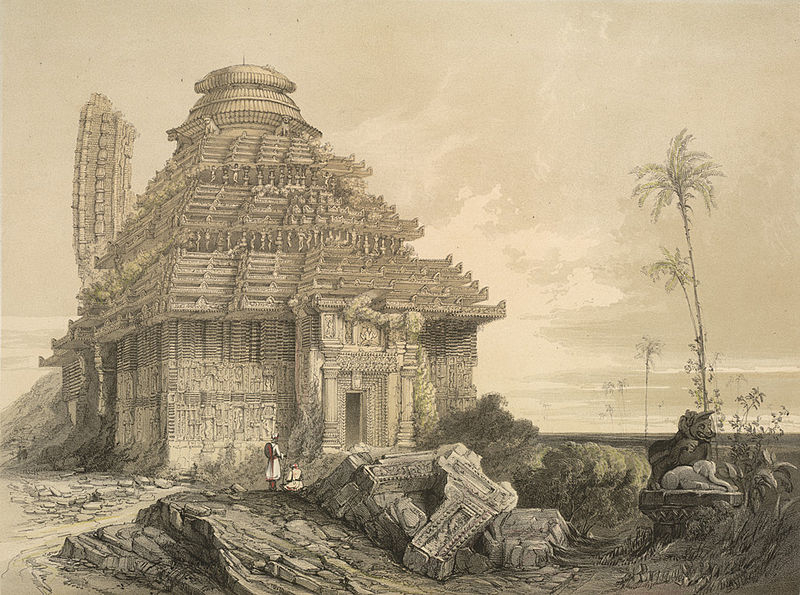
Plate 3 from James Fergusson's 'Ancient Architecture in Hindoostan'. The Sun Temple at Konark is one of the most famous of India's temples and considered a great example of Odiya architecture (Photo Source: The British Library Board, courtesy Swathi Gopalakrishnan)
Legends and Myths
Tragedy of Dharmapada: Architect Bisu Maharana, confounded by the challenge of mounting the crowning stone but faced with an impossible ultimatum, was forced to take help from his 12-year-old son Dharmapada, who had become a master of the Odiya art. Dharmapada is said to have then leapt to his death to save his illustrious father from ignominy.
Legend of Samba: Samba, the son of Krishna, was afflicted by leprosy due to a curse. After 12 years of penance, he was cured by Surya, in whose honour he then built this temple.
Architecture
Materials
Three types of stone were used in the structure—chlorite, laterite and the greenish khondalite. The stones were fully finished, polished and fitted together using iron cramps and dowels, so that the joinery was almost invisible. Two magnets held together the entire structure.
Layout and Plan
The Sun Temple complex comprises the spatial units of the Natamandapa (dance hall), Jagamohana (frontal porch) and the Rekha Deul (sanctum), arranged along the east–west axis. The Rekha Deul-Jagamohana complex forms the chariot, while the common plinth or pista forms the matrix on which the wheels and horses of the chariot are carved. The Natamandapa stands apart.
Also within the complex are two minor temples dedicated to Mayadevi (formerly to Surya) and Narayana, and what is said to be a bhogamandapa, or refectory for communal meals.
Features shared by the three primary edifices are the square plan and pancharataka, a five-stepped projection from the centre of each side to either edge. Also common to the three edifices is a tripartite elevation—a plinth, chamber walls and a roof (curvilinear in the former and pyramidal in the latter).
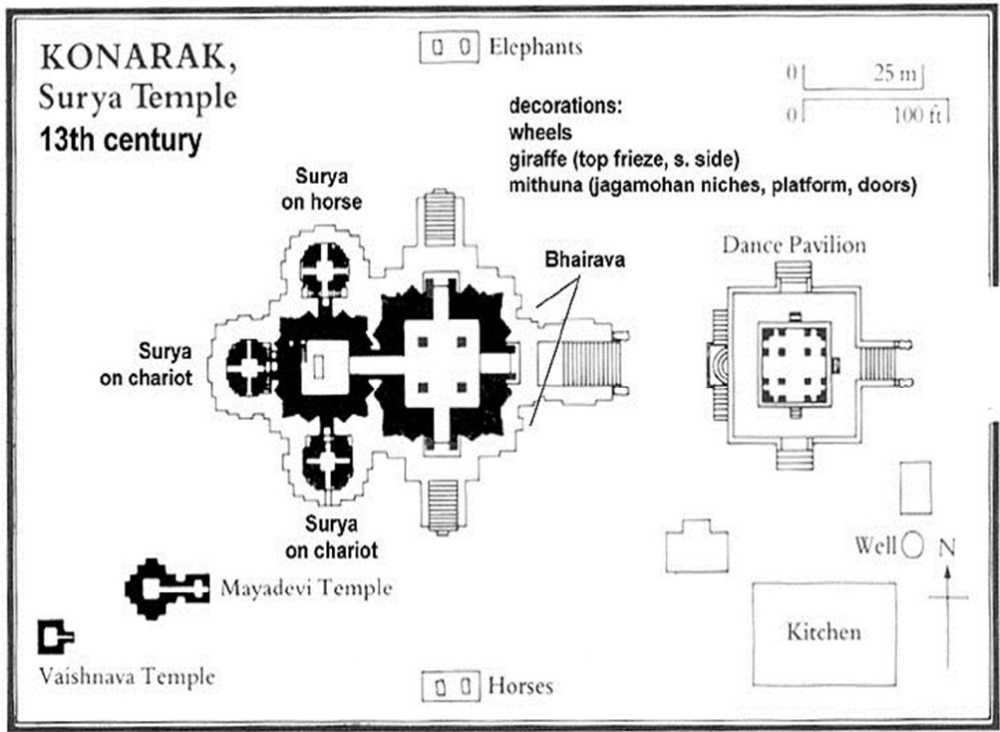
Plan of the Konark Sun Temple as depicted by Percy Brown (Photo courtesy Swathi Gopalakrishnan)
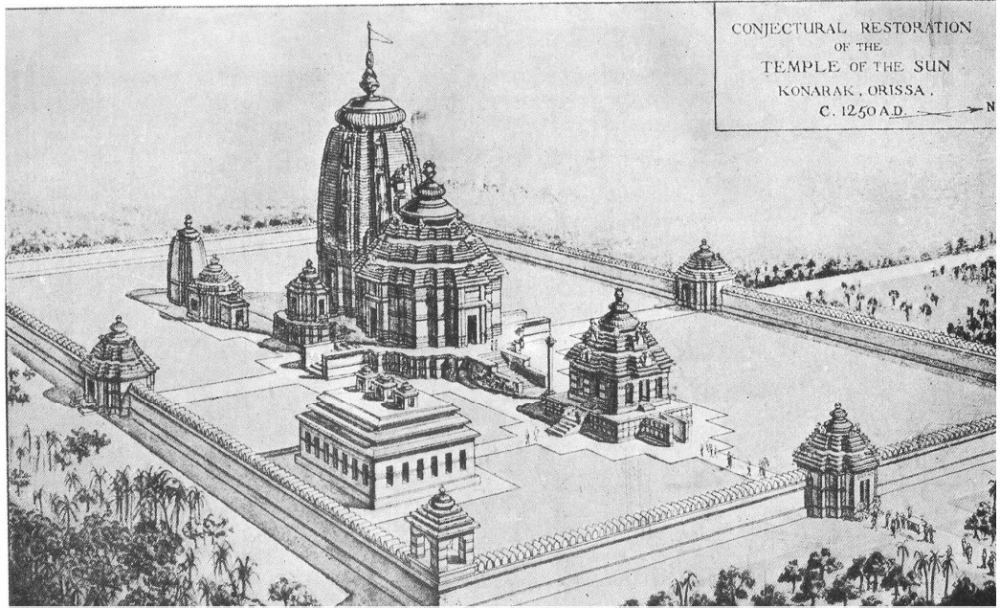
Conjectural sketch of the Konark Sun Temple by Percy Brown (Photo courtesy Swathi Gopalakrishnan)
The Rekha Deul is the largest structure in the temple complex, and was the tallest at a height of 70 m. Along its three sides are subsidiary shrines with life-sized chlorite sculptures of Surya, reached by three flights of stairs. The Dikpalas, or guardians of the eight directions, are recessed into niches on the upper registers. In the interior, a flight of steps leads down to the sanctum, which contains a single pedestal in the centre bereft of the presiding deity, but carved at the base with the image of the supplicating king .
The Jagmohana is the 100-foot high frontal porch or assembly hall, facing three successively receding tiers, the terraces between each containing statuary groups of musicians. The three sides are punctuated by ornately carved doorways and three flights of carved staircases, all with monumental images of horses and/or elephants. Set into the plinth are 24 heavily ornamented wheels, 12 on each side, while along the principal (eastern) staircase are the horses.
The Natamandapa forms the easternmost edifice, of which only the pillars of the corbelled roof remain. The pillars, plinth and staircase are intricately carved, with reliefs of dancers and maithunas (coupling men and women). Of symbolic significance is the pair of monumental gajasimha ('elephant-lion') sculptures adorning the head of the principal eastern staircase, showing a lion crushing an elephant holding a man.
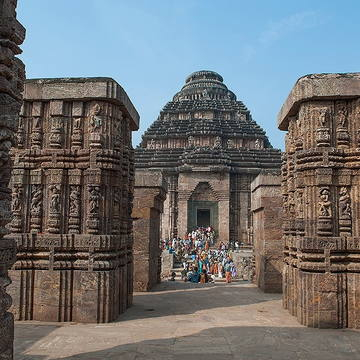
A view of Jagamohana from the Konark Temple’s Natmandapa (Photo Source: Wikimedia Commons)
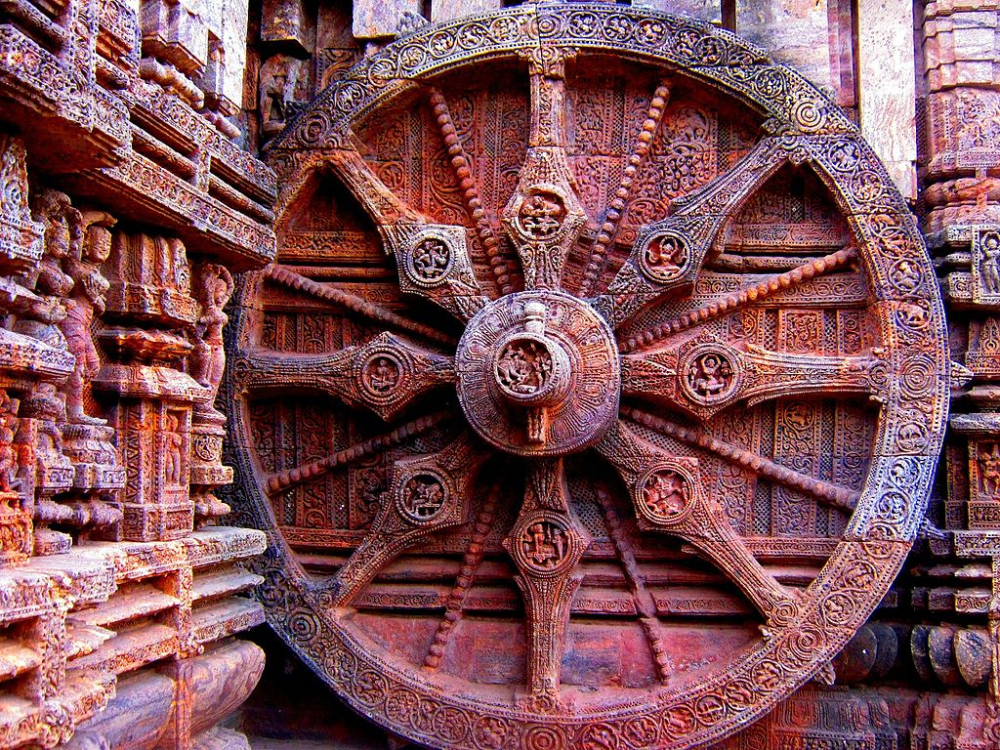
A close-up view of one of the famous wheels on which the chariot is mounted (Photo Source: Nandana Pal Chowdhury/Wikimedia Commons)
Sculpture
Most of the sculptural reliefs are arranged in bands, friezes and panels around the plinth and walls, while surface ornamentation (foliation and lotus motifs) can be found around the doorways and roof recesses. The larger sculptures are found predominantly along the stairways.
Recurring sculptural themes include scenes of royal life and military crusades; images of animals, mythical and semi-human figures; and kanyas (female figures), demi-gods and gods. The famous erotic sculptures form a continuous band around the plinth and the walls.
The Sun Temple at Konark, Odisha, forms the third point of the golden triangle of the East, with Puri and Bhubaneswar making up the other two (Photo Source: Antoniraj/Wikimedia Commons)
Symbolism
The seven horses are thought to represent the seven days of the week and the 12 wheels, the 12 months of the year. The gajasimha sculptures at the entrance of the Natamandapa are probably an allegorical reference to the ruinous fate of those who succumb to greed and pride.
The erotic imagery displayed in the second level of the temple is attributed variously to Brahmanism and tantric belief systems; and a formal programme of repopulation following the devastating Kalinga wars, through the arousal of sexual interest.
Current Status
With only the Jagamohana fully intact, other extant structures are the plinths and lower walls of the Rekha Deul, and some of the pillars in the Natamandapa. The subsidiary temples and refectory are merely skeletal.
Much of the freestanding statuary and loose stones and panels have been removed to the Konark Museum (within the same compound), and the National Museum in Delhi. The Aruna Stambha, originally in front of the main staircase, is now installed in the Puri Jagannath temple.
As a designated UNESCO World Heritage Site, the Konark temple complex is protected under the National Framework of India by the Ancient Monuments and Archaeological Sites and Remains (AMASR) Act (1958) and its Rules (1959). It also falls under the conservational purview of the Archaeological Survey of India.
On the Indian Currency Note
The Rs 10 banknote, which was announced by the Reserve Bank of India on January 5, 2018, features one of the intricately carved wheels of the Sun Temple on the reverse. (Additional reading: India's ‘Monumental’ Currency Notes: Travel the Country on Banknotes)
Fairs and Festivals
On the seventh day of Magha (January–February) crowds of people descend on Konark to take pre-dawn purification dips in a pool, a vestige of the Chandrabhaga river. A fair accompanies this ritual congregation.
One of the biggest dance festivals in Odisha, the five-day Konark Dance Festival, is held in December against the backdrop of the Sun Temple.
References
Brown, Percy. Indian Architecture (Buddhist and Hindu period). Read Books, 2010 [1940].
Das, J.P., ‘Immortalised in Stone: The Life and Times of King Narasimha’, The India Magazine 2, no. 10.
Harle, J.C. The Art and Architecture of the Indian Subcontinent. Ithaca: Yale University Press, 1994.
Michell, George. The Penguin Guide to the Monuments of India, vol. I: Buddhist, Jain and Hindu. Penguin, 1990.
Konark: Legend http://konark.nic.in/legend.htm
Sun Temple, Konarak, https://whc.unesco.org/en/list/246
Related articles on Sahapedia
'Boner and Shankar' (on Alice Boner's study of Konark Temple sculptures)
Kalinga architecture
Door Frame Designs on Nagara Temples (overview)
Rekha Deul structures
Religious Landscape of Early Medieval Radh Bengal (overview)
Bishnupur Temples (module)
World Heritage Sites in India (project)
Surya worship











